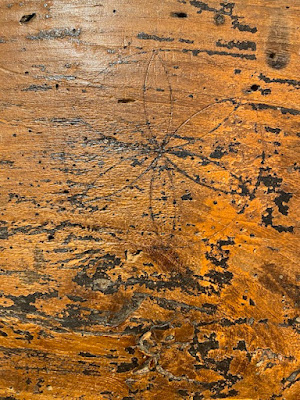In plain sight
Back in 2015 I read Matthew Champion’s fascinating book Medieval Graffiti and was alerted to the interesting array of ‘unofficial’ marks and inscriptions in English churches. This has inspired at least two posts on this bog – one on overlapping Vs, said to refer to the Virgin Mary (‘Virgo Virginum’, Virgin of virgns), another illustrating the outline of a human hand and some initials within a shield. A further common motif used in church graffiti is what is now widely known as the daisywheel, a series of arcs drawn within a circle, which combine to create an image resembling a six-petalled flower. When staying in Lavenham, Suffolk, just before Christmas, I was intrigued to come across such a daisywheel not in a church but on a wooden beam above a fireplace at Lavenham Guildhall.
The usual interpretation. of such marks is that they provide protection from evil spirits. In churches they are often placed near doorways or arches, suggesting that they prevent or discourage evil spirits form entering the building. Drawing a ritual protection mark above a fireplace suggests that it stops such spirits entering the building down the chimney.
Fireplaces are of course important places in a building – they’re the source of heat for comfort and cooking, of course, but in addition are focal points and symbols of the house and home, and of the people who live in the building or use it. For these reasons as well as the fact that the chimney offers a potential way in for evil forces, they’re a place to look out for protection marks in secular buildings. The famous ‘witch marks’ I have seen in a Worcestershire pub are also located in fireplaces – in this case on the hearth itself.
While the pub’s ‘witch marks’ consist of white circles made with chalk, daisywheels are usually incised into the wood or plaster. Matthew Champion suggests that they were made using the points of shears, a tool much used in the late Middle Ages when it’s thought many of these marks were made. He has tried making them with shears himself, with successful results. For centuries these marks were unregarded because they are easy to miss when one is not looking for them. Now scholars such as Champion have alerted us to their presence, more and more are being rediscovered, hiding as it were in plain sight.
Subscribe to:
Post Comments (Atom)




1 comment:
I didn't know chimneys were considered entry points for evil spirits, though it makes sense now I think about it -- the only entrance (before modern plumbing) that you don't routinely obstruct -- and a place of fire, smoke and darkness. It's a lot easier to imagine a spirit arriving that way than Santa Claus.
Post a Comment